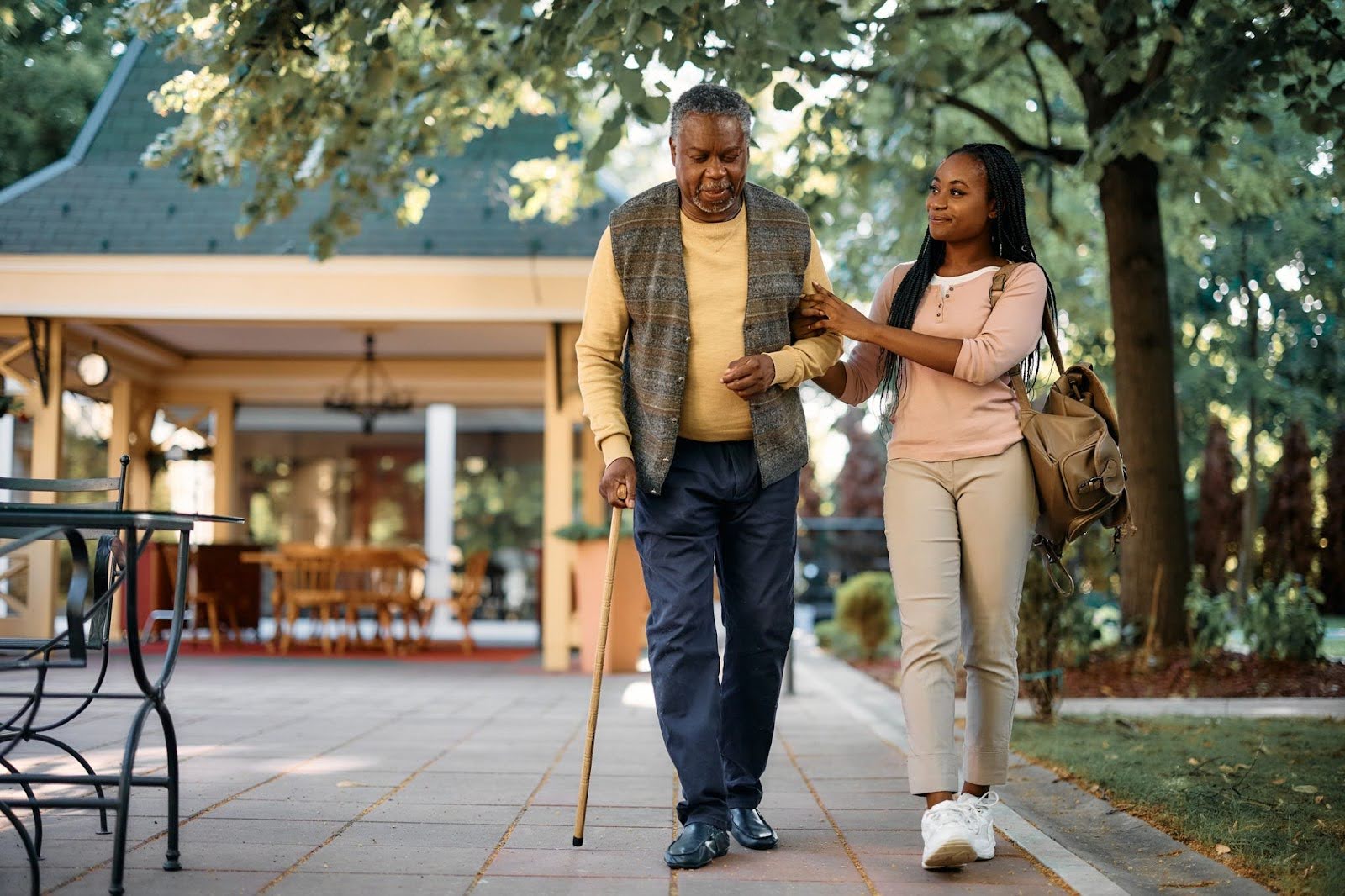As our loved ones age, it’s important to stay vigilant about their health, particularly when it comes to conditions like mini-strokes. Recognizing mini-stroke symptoms in the elderly early can make a significant difference in outcomes.
In this blog, we will explore what a mini-stroke is; its causes, symptoms, and what actions to take following an episode; and ways to reduce the chances of having a mini-stroke.
What Is a Mini-Stroke?
A mini-stroke, medically known as a transient ischemic attack (TIA), occurs when there is a temporary disruption of blood flow to the brain. This disruption is usually caused by a blood clot or a narrowing of the blood vessels leading to the brain.
Unlike a full stroke, which results in long-term brain damage, a mini-stroke doesn’t cause permanent damage and lasts only a few minutes to a couple of hours. However, it is a serious medical event that requires immediate attention and intervention.
How a Mini-Stroke Differs From a Full Stroke
The key difference between a mini-stroke and a full stroke lies in the duration and permanence of symptoms. During a mini-stroke, the blockage in the blood flow to the brain is temporary.
As a result, the symptoms often resolve on their own within a short period, usually less than 24 hours. In contrast, a full stroke involves a longer interruption of blood flow, which can lead to permanent brain damage and long-lasting or permanent symptoms.
What Are the Causes of Mini-Strokes?
Several factors can lead to mini-strokes, particularly in the elderly. Understanding these causes can help in identifying at-risk individuals and implementing preventive measures. Here are the key factors contributing to the occurrence of mini-strokes:
High Blood Pressure
Elevated blood pressure, also known as hypertension, is a primary risk factor for mini-strokes. High blood pressure can damage the arteries, making them more susceptible to clots that can block blood flow to the brain.
Over time, the increased pressure can cause the arteries to harden and narrow, which further restricts blood flow. Managing blood pressure through medication, diet and lifestyle changes is crucial in reducing the risk of mini-strokes.
High Cholesterol
High cholesterol levels in the blood can cause plaque buildup in the arteries, a condition known as atherosclerosis. Cholesterol is a fatty substance that is essential for building cells, but too much of it can be harmful.
When there is an excess of low-density lipoprotein (LDL) cholesterol, often referred to as “bad” cholesterol, it can deposit along the walls of arteries. This buildup, combined with other substances such as calcium and cellular waste, forms plaque.
Over time, plaque can harden and narrow the arteries, a process called arteriosclerosis. This narrowing restricts blood flow to vital organs, including the brain, increasing the risk of a transient ischemic attack (TIA).
A TIA occurs when a clot temporarily blocks blood flow to the brain, causing stroke-like symptoms that resolve within a short period.
Diabetes
Diabetes is a significant risk factor for mini-strokes due to its damaging effects on blood vessels. Elevated blood sugar levels in individuals with diabetes can cause a variety of complications that increase the likelihood of clots and blockages.
Smoking
Smoking is a major contributor to the development of cardiovascular diseases, including mini-strokes. The harmful chemicals in tobacco smoke can cause extensive damage to the arteries and increase the risk of blood clots.
Smoking accelerates the buildup of plaque in the arteries, a process known as atherosclerosis, which narrows and hardens the arteries, restricting blood flow to the brain. Additionally, nicotine and other chemicals in tobacco smoke raise blood pressure, further increasing the risk of mini-strokes.
This combination of plaque buildup and elevated blood pressure makes smokers significantly more prone to experiencing transient ischemic attacks (TIAs).
Family History
A family history of strokes or cardiovascular disease can indicate a higher risk of mini-strokes.
Lifestyle Factors
Factors such as weight, physical exercise, and overall lifestyle play significant roles in the risk of mini-strokes. Here’s how these elements contribute to the likelihood of experiencing a transient ischemic attack (TIA):
Obesity is a significant risk factor for mini-strokes. Excess body weight can lead to several health issues that increase the risk of TIAs, such as high blood pressure, high cholesterol, and type 2 diabetes.
Fat deposits, particularly around the abdomen, are closely linked to the development of atherosclerosis (plaque buildup in the arteries), which can restrict blood flow to the brain. Additionally, obesity can contribute to sleep apnea, a condition that disrupts breathing during sleep and can increase the risk of stroke.
Lack of physical activity is another critical factor that can elevate the risk of mini-strokes. Regular physical exercise helps maintain cardiovascular health by improving blood circulation, reducing blood pressure, and regulating cholesterol levels. It also helps manage weight and lowers the risk of developing diabetes.
Exercise stimulates the production of nitric oxide, which helps keep blood vessels flexible and reduces the likelihood of clot formation. Conversely, a sedentary lifestyle can lead to obesity, hypertension, and elevated cholesterol levels, all of which are risk factors for mini-strokes.
On the other hand, a diet rich in fruits, vegetables, whole grains, lean proteins, and healthy fats can help protect against mini-strokes by promoting overall heart health.
Excessive alcohol intake can increase blood pressure and contribute to weight gain and liver damage, all of which elevate the risk of TIAs.
Chronic stress can negatively impact cardiovascular health by raising blood pressure and leading to unhealthy coping mechanisms such as overeating, smoking, or excessive drinking. Managing stress through techniques such as meditation, yoga, and mindfulness can help reduce the risk of mini-strokes.
The Impact of High Temperatures
During summer, high temperatures can increase the risk of mini-strokes, particularly in the elderly. Heat can cause dehydration, which thickens the blood and makes it more prone to clotting. It’s vital to ensure that elderly individuals stay hydrated, avoid excessive heat, and take measures to stay cool.
Recognizing and responding promptly to mini-stroke symptoms in the elderly is critical. Understanding the causes and symptoms, along with taking preventive measures and seeking immediate medical attention, can help mitigate the risk of more severe strokes. Stay alert, especially during high-temperature periods, and prioritize a healthy lifestyle to protect your loved ones.

What Are the Symptoms of Mini-Strokes?
Recognizing the symptoms of a mini-stroke is crucial for timely medical intervention. Warning signs can vary but typically include:
Sudden Weakness or Numbness
One of the hallmark symptoms is sudden weakness or numbness, often on one side of the body, including the face, arm or leg.
Trouble Speaking
Difficulties in speaking or understanding speech are common. The person may slur words or be unable to form coherent sentences.
Blurry Vision
Sudden vision problems, such as blurred or double vision, or even temporary blindness in one eye, can indicate a mini-stroke.
Loss of Balance
A sudden loss of coordination or balance, making it hard to walk or stand, can be a sign of a TIA.
Confusion
Sudden confusion, trouble concentrating, and/or difficulty understanding simple instructions are also red flags.
What To Do After a Mini-Stroke
If you suspect that an elderly person is experiencing a mini-stroke, it is crucial to act swiftly:
Seek Immediate Medical Attention
Call emergency services immediately. Time is of the essence, even if the symptoms seem to resolve quickly.
Follow Up With a Doctor
After immediate treatment, a thorough medical evaluation is necessary to determine the cause of the mini-stroke and to plan preventive measures.
Lifestyle Modifications
Adopting a healthier lifestyle can significantly reduce the risk of future strokes. This includes:
Weight Management
Maintaining a healthy weight through a balanced diet and regular exercise can reduce the risk of conditions that lead to mini-strokes.
Regular Physical Exercisex
Encouraging regular physical activity helps improve cardiovascular health and manage blood pressure.
Stress Reduction
Managing stress through relaxation techniques, hobbies or counseling can have a positive impact on overall health.
Monitoring Blood Pressure and Cholesterol
Regularly checking and managing blood pressure and cholesterol levels is essential.

Health Services at Sierra Winds
If your loved one has had a mini-stroke, the rehabilitation team at Sierra Winds is here to support you. Our top-notch rehabilitation services help your loved one recover quickly and reduce the risk of future strokes.
Our interdisciplinary team, including doctors, nurses, social workers, dietitians and therapists, creates personalized treatment plans tailored to individual needs.
Our comprehensive rehabilitative services include:
- Physical Therapy: Regain strength, mobility and balance; manage pain; and improve respiratory function.
- Occupational Therapy: Improve fine motor skills, visual perception, and daily living tasks.
- Speech Therapy: Assist with communication, swallowing, voice projection, reading, writing and memory.
We provide priority access to community health care services for Sierra Winds residents and direct admission for seniors from Peoria and surrounding areas. Our goal is to send your loved one home stronger and more confident.
Call us today at 623-972-0212 to learn more about our services and how we can support your loved one’s recovery.

